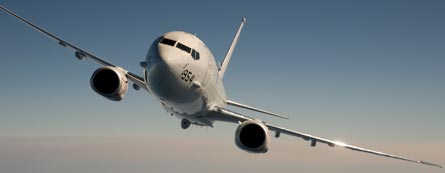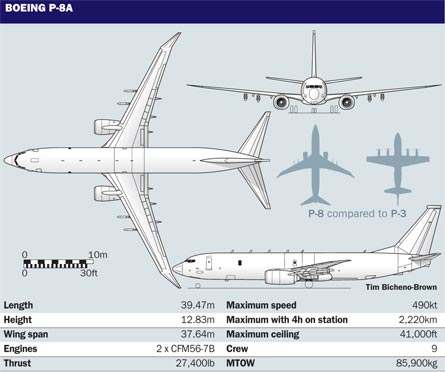Airline pilots taking a seat on the flightdeck of the US Navy's new P-8A Poseidon anti-submarine patrol aircraft would be quite comfortable except for a few oddities on the panel.
Unfamiliar to them will be a bank angle boost selector, racier autothrottles and armament and aerial refuelling panels, additions that set this strengthened, armed and self-protected version of the Boeing 737-800 apart from its commercial sector counterparts.
Those differences, along with advanced mission systems in the "cabin", were designed by Boeing for the US Navy to create a P-3C replacement that will transform the way the service performs its anti-submarine warfare (ASW), anti-surface warfare, intelligence, surveillance and reconnaissance missions for broad area, maritime and littoral operations post-2013, the start of P-8A initial operational capability.
 |
|---|
© BoeingBoeing will deliver 117 P-8As over 11 years |
The navy wants prime contractor Boeing to deliver 117 P-8As over 11 years, with technology insertion upgrade increments set for 2015 and 2018. Boeing expects to receive the first production contract this year, following up a $3.89 billion system development and demonstration contract from 2004.
Boeing is building three primary test aircraft and one static and one fatigue test airframe. Three production representative aircraft were later added to the contract. Participating in the testing phase with Boeing is the navy's VX-20 development test and evaluation squadron based at Patuxent River NAS in Maryland.
BUMPS ON A CFM THERE IS a perfectly good reason for the bumps at the 4 o'clock position on each of the two CFM56-7B turbofan nacelles on the P-8A. According to CFM, the protrusions are needed to make room for the bulkier 180kVA integrated drive generators (IDG), one for each engine, that the US Navy needed for its mission. The Boeing 737-800, on which the P-8A is largely based, uses 90kVA generators. Other differences between the commercial and military variant of the engine, CFM says, include a strengthened accessory gearbox to suit the larger IDG, "slight" adjustments to the electronic engine controls software for several control schedules to accommodate the larger IDG load, and minor configuration changes to harnesses and support brackets to handle the 180kVA upgrade. For the P-8A, CFM delivers the "bare" engine to Boeing, after which Boeing adds aircraft systems, including environmental controls, hydraulics, fire detection, anti-ice and electrical generation. Boeing also supplies the nacelle, bumps and all. |
Aside from some special provisions related to exporting, the aircraft is being built to P-8A specifications, but changes are handled in line with the commercial 737 fabrication and assembly at Boeing and its contractors. That includes 737 fuselage builder Spirit AeroSystems in Wichita, where alterations include structural strengthening and the addition of a weapons bay in the belly aft of the wings.
The weapons store includes three AGM-84K standoff missiles carried at two hard points on each wing, five stations in a heated weapons bay for Mk54 torpedoes and mines. The aircraft also has at its aft end three pressurised, three rotary and one free-fall launcher for sonobuoys, expendable devices that are dropped into the ocean to radio acoustic information back to operator workstations.
At Boeing's Renton, Washington final assembly plant, the P-8A fuselage is mated with stronger 737-900 wings and other modified airframe systems. Mission systems are installed in Seattle. "This really is an industry first - no-one else can do anything like this," says Sutorius of the in-line build process. "We might have been sceptical at first, but it has proven to be extremely beneficial for us. The only work that has to be done afterward is the installation of the missions equipment."
Mission systems include computing and display systems with dual 61cm (24in) screens at five operator stations - two acoustic stations, one non-acoustic station, one tactical co-ordination and one navigation and communications station. The P-8A stations will be completely interchangeable with respect to data. "With the P-8A, an operator can sit at any of the five stations and operate any system," says Sutorius.
 |
|---|
© BoeingInteraction between weapons configurations and the airframe was tested for a month |
Information streams include Link 11 and Link 16 tactical datalinks, Inmarsat and the US defence department's SIPRnet as well as data from "organic" sensors including an electro-optical and infrared (EO/IR) turret on the belly forward of the wing.
"We take the data and make one tactical plot and everyone can see that information," says Sutorius. "Everybody has instantaneous access to all that data." Also supporting mission and operations on board are the Raytheon AN/APY-10 radar system and Northrop Grumman-built systems for electronic support measures and early warning and self-protection from infrared guided missiles.
The P-8A is sized to be able to fly 2,220km (1,200nm) outbound, perform on-station for 4h and make the return trip to base. Once on station, the aircraft may have to take measures that would be considered extraordinary by airline standards, requiring changes to certain flight-control and alerting systems.
On the right forward instrument panel is an ASW tactics switch that allows the maximum commanded bank angle to increase to 45° from the usual 28°, a mode that also "cleans up some other things for us", says John Verniest, the P-8A integrated test team operational flight test director for the navy. The clean-up includes removing the normal alerts that would be issued when flying below 1,000ft (305m) with landing gear and flaps stowed.
 |
|---|
P-8A pilots will use the lower display unit in the centre of the flightdeck as a tactical situational awareness tool to show pertinent flight tracks and sensor information. Verniest says commercial pilots generally fly with the display blank, bringing up detailed hydraulic or engine information if needed. For the P-8A, the same information will be presented in compressed format in an upper display unit if needed, an option also available on civil versions. Video from sensors can be shown on the inward or lower display units.
The same Rockwell Collins head-up guidance system available for civil 737-800s will be included in the P-8A on the left side. Differences in symbology include the angle-of-attack reading replaced with g force in the Z (vertical) axis. The aircraft does not have an option for an enhanced vision system, says Verniest.
Given that more aggressive manoeuvring will be likely, the P-8A also has higher autothrottle gains to help the two CFM International CFM56-7B engines react faster to airspeed commands. Specific changes to the engines include doubling the size of the electrical generators on each to 180kVA from 90kVA, says Verniest.
EMEDS: KNOCKING OFF THE ICE WHILE THE 737-800 uses pneumatic boots for radome de-icing and hot bleed air for anti-icing on its main wing leading edges, the addition of raked winglets and the need for icing protection on the tail surfaces, a first for the 737 family, led designers to include a relatively unknown technology in the battle of the ice -- electrically powered electro-mechanical expulsion de-icing systems (EMEDS). Built by Long Island-based Cox and Company, EMEDS shakes the ice off an airframe by vibrating an aluminium or stainless steel leading edge with enough energy to dislodge ice thicker than 0.15cm (0.06in). Driving the slight changes in shape to the leading edge at high frequency are actuators in the cavity behind the leading edge. The technology is used for ice protection on some Hawker Beechcraft business jets and on the US Navy's Global Hawk unmanned aircraft. |
Structural upgrades to the fuselage, wings and tail required to support the more aggressive tactics and all-weather mission were designed in from the start. "It's a vastly different envelope and loads," says Boeing's senior technical integration manager Guy Granger. "The intensity of usage, the number of times at which it will be in high-load factor turns, is much more severe than for the 737."
Most obvious physical changes to the aircraft include the absence of windows, 777-style raked wingtips rather than blended winglets, the EO/IR turret on the forward belly and a variety of mission antennas and fairings.
Not so obvious are internal modifications to support the mission. Included are electro-mechanical expulsion de-icing systems (EMEDS) installed on the leading edges of the raked wingtips, horizontal and vertical stabilisers.
Also hidden most of the time is an aerial refuelling port at the top of the fuselage just aft of the cockpit. Although not required for the mission profile, the navy decided to take advantage of the refuelling modifications that had been developed for the 737-based Wedgetail airborne early warning and control aircraft programme for the Australian defence forces.
Crews will largely learn to operate the aerial refuelling and other systems using simulators purchased from Boeing as part of a plan to achieve a three-to-one ratio of simulator-to-live flying for training and mission simulations, says Jim Reining, the navy's P-8A integrated test team government flight test director.
"It's soup to nuts, taking in the full gamut from initial qualification to mission readiness for the fleet," says Reining of the P-8A simulator training agenda.
Reining says there will be 11 full-motion cockpit simulators in Jacksonville, Florida, the initial training location for P-8A pilots, and nine weapons system trainers, each with five operator workstations, to simulate the on-board mission systems.
Cockpits are linked with the weapons trainers directly, but are also network enabled to link to live exercises.
SUPER SIMULATORS: NOT YOUR FATHER'S VIRTUAL BOEING 737
TEST PILOTS who have flown a large transport aircraft into a deep, or post-stall region, know that full-flight simulators on today's civil market do not quite do justice to the way an aircraft handles beyond the relatively narrow realm covered by flight test and windtunnel test points. Experts say that while a large transport simulator will have a benign pitch break at stall where the aircraft's nose drops to pick up speed, the behaviour in the real world can include a pronounced roll angle as pitch drops off, with a loss of dynamic damping and control surface effectiveness, especially with flaps extended.
For military pilots, simulator envelopes, especially for fighters, have been much broader than civil ones in terms of accurate control handling and visual motion in all manner of attitudes for the obvious reasons that pilots engaged in life-or-death situations have to be able to manoeuvre. It is crucial from a "fly like you train, and train like you fly" standpoint to get the simulator right.
For that reason, the US Navy's P-8A programme has been developing an enhanced aerodynamic model for its 22 full-motion simulators in Florida, Hawaii and Washington.
Using commercial simulator analytical models from Boeing as a starting point, contractors are strengthening the models with findings from windtunnel testing of subscale models at angles of attack up to 90°. In the near future, data will be gathered during live stall testing on P-8A test aircraft, all of which will be mapped back into the P-8A's simulators.
Source: Flight International



























